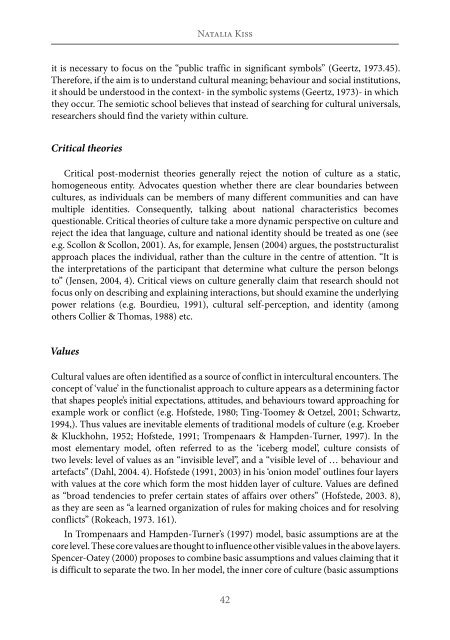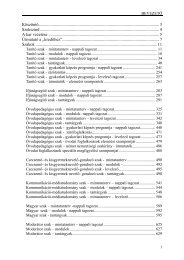ACTA SZEKSZARDIENSIUM - Pécsi Tudományegyetem Illyés Gyula ...
ACTA SZEKSZARDIENSIUM - Pécsi Tudományegyetem Illyés Gyula ...
ACTA SZEKSZARDIENSIUM - Pécsi Tudományegyetem Illyés Gyula ...
Create successful ePaper yourself
Turn your PDF publications into a flip-book with our unique Google optimized e-Paper software.
Natalia Kiss<br />
it is necessary to focus on the “public traffic in significant symbols” (Geertz, 1973.45).<br />
Therefore, if the aim is to understand cultural meaning; behaviour and social institutions,<br />
it should be understood in the context- in the symbolic systems (Geertz, 1973)- in which<br />
they occur. The semiotic school believes that instead of searching for cultural universals,<br />
researchers should find the variety within culture.<br />
Critical theories<br />
Critical post-modernist theories generally reject the notion of culture as a static,<br />
homogeneous entity. Advocates question whether there are clear boundaries between<br />
cultures, as individuals can be members of many different communities and can have<br />
multiple identities. Consequently, talking about national characteristics becomes<br />
questionable. Critical theories of culture take a more dynamic perspective on culture and<br />
reject the idea that language, culture and national identity should be treated as one (see<br />
e.g. Scollon & Scollon, 2001). As, for example, Jensen (2004) argues, the poststructuralist<br />
approach places the individual, rather than the culture in the centre of attention. “It is<br />
the interpretations of the participant that determine what culture the person belongs<br />
to” (Jensen, 2004, 4). Critical views on culture generally claim that research should not<br />
focus only on describing and explaining interactions, but should examine the underlying<br />
power relations (e.g. Bourdieu, 1991), cultural self-perception, and identity (among<br />
others Collier & Thomas, 1988) etc.<br />
Values<br />
Cultural values are often identified as a source of conflict in intercultural encounters. The<br />
concept of ‘value’ in the functionalist approach to culture appears as a determining factor<br />
that shapes people’s initial expectations, attitudes, and behaviours toward approaching for<br />
example work or conflict (e.g. Hofstede, 1980; Ting-Toomey & Oetzel, 2001; Schwartz,<br />
1994,). Thus values are inevitable elements of traditional models of culture (e.g. Kroeber<br />
& Kluckhohn, 1952; Hofstede, 1991; Trompenaars & Hampden-Turner, 1997). In the<br />
most elementary model, often referred to as the ‘iceberg model’, culture consists of<br />
two levels: level of values as an “invisible level”, and a “visible level of … behaviour and<br />
artefacts” (Dahl, 2004. 4). Hofstede (1991, 2003) in his ‘onion model’ outlines four layers<br />
with values at the core which form the most hidden layer of culture. Values are defined<br />
as “broad tendencies to prefer certain states of affairs over others” (Hofstede, 2003. 8),<br />
as they are seen as “a learned organization of rules for making choices and for resolving<br />
conflicts” (Rokeach, 1973. 161).<br />
In Trompenaars and Hampden-Turner’s (1997) model, basic assumptions are at the<br />
core level. These core values are thought to influence other visible values in the above layers.<br />
Spencer-Oatey (2000) proposes to combine basic assumptions and values claiming that it<br />
is difficult to separate the two. In her model, the inner core of culture (basic assumptions<br />
42




